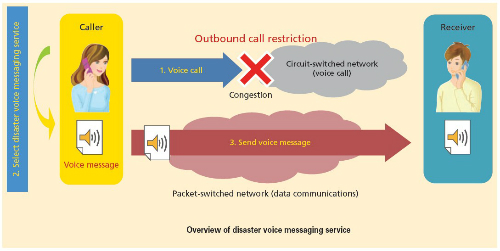The use of technology to improve humanitarian action and make disaster preparedness and response more efficient has been increasing in the past number of years. A large number of mobile operators have been leading this trend and have released products or services that can be used by subscribers in disaster scenarios. Some of these involve a subscriber personal alarm or wider public alert systems and others involve clever innovations around the network itself. In this blog we look at what NTT DoCoMo in Japan have developed to enable communications between isolated loved ones over congested mobile networks.
This is the first in a series of blogs where local, national or international innovations using mobile or mobile networks in the disaster response area will be highlighted.
NTT DoCoMo Disaster Messaging Service
In the immediate aftermath of a disaster such as an earthquake or a tropical cyclone, a mobile operator’s capacity can be reduced for two reasons. Firstly, the network infrastructure itself could be damaged leading to reduced bandwidth on the backhaul or at cell-sites. Secondly, this is the time that people upon hearing the news, reach for their mobile to make a call to friends and family in the affected region. In these times of uncertainty, a simple text is rarely enough for panicked relatives and so the voice (circuit-switched) network becomes ever more congested. Conversely, the data (packet-switched) network is quite often not congested at all at these times. For instance, in the immediate aftermath of the Great East Japan Earthquake in 2011 on the NTT DoCoMo voice network, originating-call attempts jumped 60 fold and receiving-call attempts jumped 40 fold when compared to levels just prior to the earthquake. However, on the data network, traffic levels only jumped 3 or 4 fold. NTT DoCoMo took note of these variations in signalling load increases and developed a disaster messaging service where messages for intended recipients are taken and sent over the packet switched network in order to reach their destination.
When using this service, voice messages are recorded at the originating handset, creating voice files. These voice files are transmitted through the mobile network using a special messaging centre and once notification is received at the destination handset can be played back by the recipient. This allows people to receive updates from loved ones when the network is congested, battery power is low (often an issue in post-disaster scenarios) or the user is offline for other reasons. All of this happens within a special app for smartphones and tablets that NTT DoCoMo have developed specifically for this purpose called Disaster Kit.
Any disaster response or business continuity plan or framework should involve simulations where responders can practice and refine their skills, improve knowledge of equipment and strengthen partnerships. Emergency responders regularly state that if you don’t have the correct point of contact, phone numbers, lists and technology in advance of a response then it is generally too late to try and establish the same, by the time the need for an actual response arrives. In these stressful and often harrowing circumstances, trying new technology can prove beyond even the most normally technically adept of people. NTT DoCoMo have taken this philosophy and brought it to the level of their subscribers, so they can practice the use of this technology under normal circumstances. A dummy run for this service is available to subscribers in order to familiarise themselves with the service. The service is available at these times:
- The 1st and 15th of every month (0:00 a.m. to 11:59 p.m.)
- Three days at New Year’s (from noon on January 1 to 11:00 p.m., January 3)
- During Disaster Prevention Week (from August 30 to September 5)
- During Disaster Prevention and Volunteer Week (from January 15 to January 21)
NTT are to be applauded for their innovation on two fronts. Firstly, the analysis of disaster statistics and traffic loads which lead to the idea of using what space can exist somewhere on a congested network. Secondly, rolling this innovation out to the public and allowing them to become familiar with the technology.
More information and a detailed step by step guide is available online at the NTT Docomo website.


